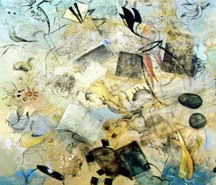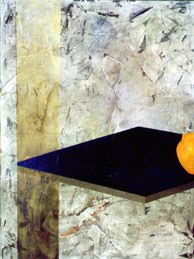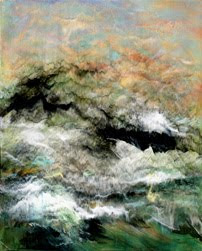A Positive Look at Negative Space

To the left is a painting by M. C. Escher who used this optical trick idea as the basis of his work. In my class I noticed that figures would get out of proportion if students only focused on the positive form – the figure – but when they consciously drew the space around the figure – the background or negative space – the figure would improve tremendously. The phrase “negative space” must have seemed too negative to some, because I noticed other teachers referring to it as “Figure-Ground”. My favorite phrase was “Figure and Arena” which reminded me of a performer in a circus. When I started teaching abstract painting I liked to use the term “charged space” instead of our old buddy “negative space”.
A friend of mine gave me a refreshing look on this subject. He would look at someone’s painting, and analyze it by seeing the background as the artist’s “inner” self, and whatever forms were painted (objects for a still life, brushmarks in an abstraction) symbolized the artist’s projected personality – what parts of ourselves we allow visible to other people. I decided to look at my work retrospectively in these terms and was surprised to find that in fact, there must be some truth to this.
Here t
 o the left is a painting I did years ago. There are many floating forms, and it has a crowded or busy feel to it. At the time I painted it I was trying to deal with lots of obligations in my life – not enough time spent alone.
o the left is a painting I did years ago. There are many floating forms, and it has a crowded or busy feel to it. At the time I painted it I was trying to deal with lots of obligations in my life – not enough time spent alone.Then I painted the one below. It’s hilarious to see that I have actually pushed the forms off the canvas, but still hanging on "stage" at the far right edge. At that time I was spending more time alone in my studio.

Now I am meditating much more on a daily basis, especially before I paint, and my current work feels like its all “charged space”, and in fact I like calling them “energy fields”.

Labels: Artist to Artist

